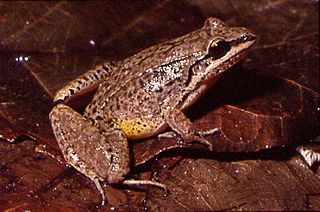
Dryaderces inframaculata is a species of frog in the family Hylidae. It is endemic to Brazil and known from between the Tapajós and Xingu Rivers in Pará. Until recently, it was only known from one specimen collected near Santarém, probably around 1876, by Henry Wickham. Common name Santarem treefrog has been coined for it.
Hyperolius kihangensis, also known as the Kihanga reed frog or volcano reed frog, is a species of frogs in the family Hyperoliidae. It is endemic to the Udzungwa Mountains in south-central Tanzania.
Cycloramphus acangatan is a species of frog in the family Cycloramphidae. It is endemic to the Serra de Paranapiacaba, the state of São Paulo state, Brazil. The specific name acangatan is derived from the Tupi language words acanga ("head") and atan ("strong") and refers to the strong and massive jaw adductor muscles in this species.
Cycloramphus dubius is a species of frog in the family Cycloramphidae. It is endemic to the state of São Paulo, Brazil. Common name São Paulo button frog has been coined for it.
Cycloramphus duseni is a species of frog in the family Cycloramphidae. It is endemic to southern Brazil and only known from its type series collected in 1911 from near Casa Ypiranga along the Curitiba–Paranaguá railway, in the Serra do Mar, Paraná state. Prior to naming of Cycloramphus izecksohni in 1983, it was confused with this species. The specific name duseni honors Per Dusén, Swedish naturalist who collected the type series. Common name Ypiranga button frog has been coined for this species.

Cycloramphus eleutherodactylus is a species of frog in the family Cycloramphidae. It is endemic to the Serra do Mar in southeastern Brazil, including the Serra dos Órgãos, Serra da Mantiqueira, and Serra da Bocaina. Common name Alto button frog has been coined for it.
Cycloramphus izecksohni is a species of frog in the family Cycloramphidae. It is endemic to southern Brazil and occurs in the Serra do Mar in the states of Santa Catarina, Paraná, and São Paulo. Prior to its description in 1983, it was confused with Cycloramphus duseni. Common name Izecksohn's button frog has been coined for this species.

Cycloramphus stejnegeri is a species of frog in the family Cycloramphidae. It is endemic to the Serra dos Órgãos in southeastern Brazil. The specific name stejnegeri honors Leonhard Stejneger, a Norwegian–American herpetologist and ornithologist. Common name Stejneger's button frog has been coined for this species.
Strabomantis cornutus is a species of frog in the family Strabomantidae. It is found along the eastern flank of the Andes of Ecuador and Colombia north to Caquetá Department. Common name Rio Suno robber frog has been coined for it. It has been confused with other species.
Eleutherodactylus dolomedes is a species of frog in the family Eleutherodactylidae. It is endemic to the Massif de la Hotte, Haiti.

Leptodactylus mystacinus is a species of frog in the family Leptodactylidae. It is found in eastern Bolivia and eastwards to Brazil, Paraguay, and Uruguay and southwards to central Argentina. It is also known as the mustached frog.

Leptodactylus notoaktites is a species of frog in the family Leptodactylidae. It is endemic to southeastern Brazil and is known from the states of Santa Catarina, Paraná, and São Paulo state. Common name Iporanga white-lipped frog has been coined for it.

Leptodactylus spixi is a species of frog in the family Leptodactylidae. It is endemic to eastern Brazil and occurs in the Atlantic forests of the Bahia, Espírito Santo, and Rio de Janeiro states. The specific name spixi honors Johann Baptist von Spix, a German naturalist who worked in Brazil. Prior to its description, this species had been referred to as Leptodactylus mystaceus(Spix, 1824). Common name Spix's white-lipped frog has been coined for this species.

Leptodactylus syphax is a species of frog in the family Leptodactylidae. It is found in extreme eastern Bolivia, central to northeastern Brazil, and Paraguay. Common names basin white-lipped frog and whistling foam frog have been coined for it.
Thoropa saxatilis is a species of frog in the family Cycloramphidae. It is endemic to southern Brazil and occurs in the Santa Catarina and Rio Grande do Sul states, corresponding to the southernmost extent of the Atlantic Forest biome. The specific name saxatilis refers to its association with rocks. Common name Brazilian river frog has been coined for it.
Oreophryne minuta is a species of frog in the family Microhylidae. It is endemic to Papua, Western New Guinea, and only known from its type locality in the Derewo River basin, in the mountains to the southeast of Cenderawasih Bay. It is a very small frog, and at the time of species description, the smallest Oreophryne species.
Xenorhina subcrocea is a species of frog in the family Microhylidae. It is endemic to Papua New Guinea and is known from the New Guinean north coast, including coastal ranges between Vanimo and Lae. Common name Lae fanged frog has been coined for it.
Phrynobatrachus bullans is a species of frog in the family Phrynobatrachidae. It is found in northern and central inland Tanzania, southern Ethiopia, and southwestern Kenya. Common name bubbling puddle frog has been coined for it.
Cycloramphus faustoi is a species of frog in the family Cycloramphidae. It is endemic to Ilha dos Alcatrazes, a small island about 35 km off the coast of São Paulo state, Brazil.
Papurana aurata is a species of true frog, the family Ranidae. It is only known from the area of its type locality near Nabire, in the Indonesian province of Papua, in New Guinea. The specific name aurata is Latin and refers to the gold-like colour of adult males.








